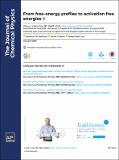From free-energy profiles to activation free energies
Author(s)
Dietschreit, Johannes CB; Diestler, Dennis J; Hulm, Andreas; Ochsenfeld, Christian; Gómez-Bombarelli, Rafael
DownloadPublished version (4.731Mb)
Publisher with Creative Commons License
Publisher with Creative Commons License
Creative Commons Attribution
Terms of use
Metadata
Show full item recordAbstract
<jats:p> Given a chemical reaction going from reactant (R) to the product (P) on a potential energy surface (PES) and a collective variable (CV) discriminating between R and P, we define the free-energy profile (FEP) as the logarithm of the marginal Boltzmann distribution of the CV. This FEP is not a true free energy. Nevertheless, it is common to treat the FEP as the “free-energy” analog of the minimum potential energy path and to take the activation free energy, [Formula: see text], as the difference between the maximum at the transition state and the minimum at R. We show that this approximation can result in large errors. The FEP depends on the CV and is, therefore, not unique. For the same reaction, different discriminating CVs can yield different [Formula: see text]. We derive an exact expression for the activation free energy that avoids this ambiguity. We find [Formula: see text] to be a combination of the probability of the system being in the reactant state, the probability density on the dividing surface, and the thermal de Broglie wavelength associated with the transition. We apply our formalism to simple analytic models and realistic chemical systems and show that the FEP-based approximation applies only at low temperatures for CVs with a small effective mass. Most chemical reactions occur on complex, high-dimensional PES that cannot be treated analytically and pose the added challenge of choosing a good CV. We study the influence of that choice and find that, while the reaction free energy is largely unaffected, [Formula: see text] is quite sensitive. </jats:p>
Date issued
2022-08-28Department
Massachusetts Institute of Technology. Department of Materials Science and EngineeringJournal
The Journal of Chemical Physics
Publisher
AIP Publishing
Citation
Dietschreit, Johannes CB, Diestler, Dennis J, Hulm, Andreas, Ochsenfeld, Christian and Gómez-Bombarelli, Rafael. 2022. "From free-energy profiles to activation free energies." The Journal of Chemical Physics, 157 (8).
Version: Final published version